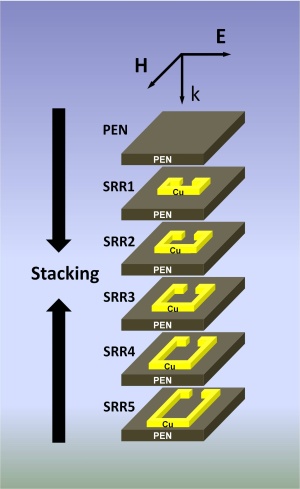
Stacked multiple layers of different-size ‘C’-shaped split-ring resonators (SSRs) made of copper (Cu) on polyethylene naphthalate (PEN) films suppress the transmission of terahertz radiation in a broad frequency window. The axes indicate the orientation of the electric (E) and magnetic (H) field components of the terahertz light incident along the k-direction.
Terahertz radiation — electromagnetic radiation propagating at frequencies between those of microwave and infrared radiation — is ideal for medical imaging and security screening applications because it is non-ionizing to biological tissues and highly penetrating to materials like plastics and paper, commonly encountered in security screening. However, the radiation does not generate much response in conventional materials. For this reason, scientists have developed ‘metamaterials’ for detecting terahertz signals in broadband applications.
A terahertz metamaterial is typically made by patterning a periodic array of sub-wavelength microstructures onto a rigid substrate, made of either silicon or glass. Minghui Hong and co-workers at the A*STAR Data Storage Institute, working in collaboration with the National University of Singapore and Imperial College London have now fabricated a flexible metamaterial by substituting the rigid substrate with plastic.
The researchers stacked multiple periodic arrays of ‘split-ring resonators’ alternatively between polyethylene naphthalate films. A split-ring resonator is a metallic ring with a small bit cut off; it resembles the shape of the letter ‘C’. Incident radiation pushes electrons in the ring to move back and forth between the ends of the resonator, creating a build-up of electrons across the gap. If the frequency of the radiation is ‘right’, the energy of the incoming radiation is transferred very efficiently to the electrons.
Such frequency is known as resonant frequency. At this frequency, the electrons resonate in tandem with the incident electromagnetic waves. In a metamaterial containing many resonators arranged into two-dimensional periodic arrays, this effect is amplified such that resonant incident light is strongly absorbed by the metamaterial resulting in a deep, sharp dip in the light transmission spectrum.
According to the researchers, the resonant frequency of the metamaterial is dependent on the geometrical and material parameters of the split-ring resonators. Changing the resonator loop area and the gap distance between its ends can sensitively tune the shape and frequency of the transmission dip.
The researchers exploited this tunability and created a broadband filter for terahertz radiation. Through laser lithography, they patterned multiple arrays of copper split-ring resonators alternatively between polyethylene naphthalate films (see image). By adjusting the array geometry, the resonant responses are offset to partly overlap, resulting in a cumulative 0.38 terahertz frequency window in which incident radiation is blocked.
According to the researchers, the frequency window can be tailored by adding or subtracting layers, as well as changing the array design. The reported device has also been shown to compare favorably with other terahertz bandpass filters in the literature in terms of physical characteristics, for example reaching an attenuation level as high as 30 decibels, as well as processing complexity and ease of design.
The A*STAR-affiliated researchers contributing to this research are from the Data Storage Institute.



